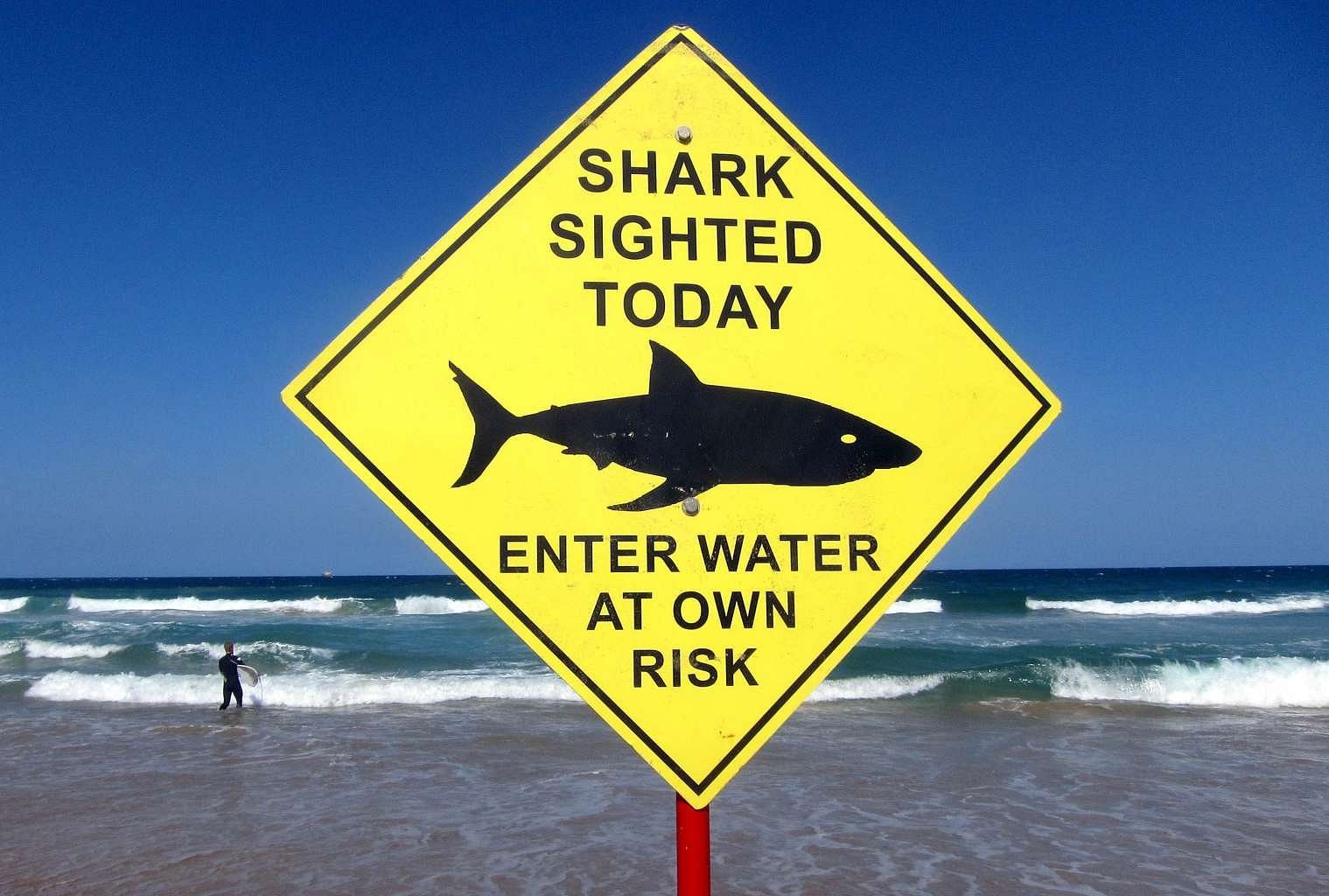World's most shark-infested areas and how to stay safe from shark attacks
Sign up now: Get ST's newsletters delivered to your inbox

A sign declaring a shark sighting on Sydney's Manly Beach, in Australia, on Nov 24, 2015.
PHOTO: REUTERS
Nicole Weers
Follow topic:
A record 98 shark attacks, with six deaths, occurred around the world in 2015, CNN reported.
According to the International Shark Attack File at the University of Florida, this was an increase from the previous record of 88 shark attacks in 2000.
The most recent case of an attack was on Sunday (June 5) when Mrs Doreen Collyer, 60, was killed while diving off Mindarie Beach, about 35km north of Perth.
It happened just two days after surfer Ben Gerring, 29, died in hospital after his leg was mauled by a shark while surfing off Falcon Beach, 115km south of Mindarie on May 31.
Closer to Singapore's shores, an American surfer, Mr Ryan Boarman, 26, was mauled by a shark in Bali, Indonesia, on April 25. He sought medical treatment at Raffles Hospital in Singapore and had surgery on his right arm.

So for those who are thinking of hitting the surf, here is a list of the world's most shark-infested areas:
1. United States: Florida and California
Based on data provided by the Florida Museum of Natural History's International Shark Attack File, Florida is the area most prone to shark attacks.
The state chalked up a total of 219 shark attacks between 2005 and 2014, and New Smyrna, Florida, has been deemed the shark attack capital of the world.
Elsewhere in the US, there have been a number of shark attacks in California.
On May 29, personal trainer and aerobics instructor Maria Korcsmaros, 52, was bitten at Newport Beach, California.
This occurred on the same day a 13-year-old boy in Neptune Beach in Florida was attacked on his right leg.
2. Australia: New South Wales and Queensland
Australia comes in second as the world's most shark-infested waters, with 123 shark attacks between 2005 and 2014, according to the Florida Museum of Natural History's International Shark Attack File.
More than 60 sharks were seen on the coast of New South Wales in a span of two days, reported the International Business Times in December 2015.
Surfer Brett Connellan, 22, lost three-quarters of his left thigh in a shark attack at Bombo Beach, New South Wales, on March 30.
In Queensland , a 30-year-old man suffered shark bites on his arms and legs while swimming off central Queensland on Jan 2.
A few days later, an 11-year-old boy was bitten in central Queensland while wading in knee-high water.
3. South Africa
Gansbaai, a fishing town and tourist destination in South Africa, is known as the great white shark capital of the world.
Many of these sharks can be spotted in Shark Alley, which is a narrow sea channel between Geyser Rock and Dyer Island.
One of Gansbaai's tourist attractions is the shark cage diving, which involves submerging adventurous divers in a cage underwater.
Resort city Umhlanga Rocks is also home to great white sharks and bull sharks.
Shark attacks in the area were so frequent - five swimmers killed by sharks in 100 days - that fishing nets were installed in 1957 to protect swimmers.
Scientists in Umhlanga have also created a shark-repelling device known as the Protective Oceanic Device (POD) for divers and surfers to wear.
4. Brazil
Ms Bruni Gobbi, 18, was swimming at Boa Viagem beach located in the north-eastern Brazil city of Recife in July 2013 when she was attacked by a shark as she was waiting to be rescued out at sea with her cousin.
She later died in a hospital due to heavy blood loss.
Danger lurks at the beaches of Recife, a Brazilian city notorious for having one of the highest shark attack rates in the world.
BBC News reported that between 1992 and 2012, a total of 56 attacks occurred in the city's waters, 21 of which were fatal.
5. Asia: Vietnam and Philippines
Although the waters in Asia are less shark infested compared to other places in the world, there have been a few cases of attacks in countries close to Singapore's shores.
From 2009 to 2010, Quy Nhon Bay in Vietnam saw an increase in shark bites, with a total of 79 attacks in one year.
In the Philippines, a group of fishermen reportedly found remains of a human head and a leg inside the belly of a huge tiger shark in the waters between Bohol and Camiguin Islands in Nov 2014.
Here are some safety tips when visiting these places:
1. Wear appropriate clothing
It is advisable for people going into the water to wear clothes with dark and dull colours. Avoid wearing swimsuits with patterns and bright hues such as yellow, orange and white.
This is because sharks see only in black and white, so bright colours allow them to see better because of the contrast of shades.
Avoid wearing any shiny jewellery as the light reflected will resemble fish scales in the water.
2. Stay out of the water if you are bleeding
Do not go into the water if you are bleeding as sharks are able to taste and smell blood, and will be attracted by it.
3. Stay away from polluted waters and areas being used by fishermen
Swimming in contaminated or dirty water might lead to an encounter, as you and the shark will have trouble seeing in murky waters. The shark might confuse you for prey.
Water polluted with sewage may attract fish which serve as prey for sharks.
Do not swim in areas where fishing bait may be present as sharks can smell the bait from a distance.
4. Avoid swimming at night
Sharks are most active during sunset to sunrise and may move closer to the shore to feed on fish.
They have a good sense of sight and are able to locate their prey even during night time.
5. Stay in a group when taking part in water activities
Sharks are less likely to attack a group and in the event of a shark attack against one of the group members, there will be others around to render help.
6. Remain calm
Refrain from splashing around or making erratic movements.
Sharks are attracted to such activity as it reminds them of fish or other aquatic animals in the water.
Stay still if you see a shark. Most sharks will leave without attacking.
7. Defend yourself
Protect yourself with any items or weapons around you, such as using your surfboard as a defensive shield.
If you have to use your bare hands, try to fight back by targeting its sensitive and delicate areas - the eyes, nose and gills.
Sources: CNN, BBC News, Florida Museum of Natural History's International Shark Attack File, International Business Times, Daily Mail Online, National Geographic News.

